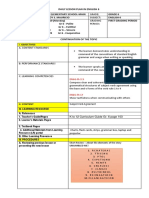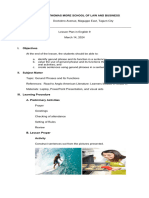Q1WLP ENGLISH W5 Day1
Q1WLP ENGLISH W5 Day1
Uploaded by
SachiCopyright:
Available Formats
Q1WLP ENGLISH W5 Day1
Q1WLP ENGLISH W5 Day1
Uploaded by
SachiOriginal Description:
Original Title
Copyright
Available Formats
Share this document
Did you find this document useful?
Is this content inappropriate?
Copyright:
Available Formats
Q1WLP ENGLISH W5 Day1
Q1WLP ENGLISH W5 Day1
Uploaded by
SachiCopyright:
Available Formats
Weekly Learning Plan in English 5
School: Teacher:
Quarter: ONE Grade Level: FIVE
Week: 6 Date:
DAY 1 (Monday)
Topic: Objective:
CAUSE-AND-EFFECT AND Use compound and complex sentences to show cause-and-effect
PROBLEM-SOLUTION and problem-solution relationship of ideas
PROCEDURE:
A. Reviewing previous lesson or Review compound and complex sentences.
presenting the new lesson (drill, What is a compound sentence? Complex?
review, unlocking of difficulties)
B. Establishing a purpose for the Sentences are important features of language. As a second language
lesson (Motivation) learner, you must learn the different conventions of writing sentences.
You should aim to be able to compose clear and coherent sentences
using appropriate grammatical structures such as subject-verb
agreement, kinds of adjectives, subordinating and coordinating
conjunctions, and adverbs of intensity and frequency.
C. Presenting examples/instances of
the new lesson
D. Discussing new concepts and Learning Task 2.p 25 module in English
practicing new skills #1
E. Discussing new concepts and A. SUBJECT-VERB AGREEMENT
practicing new skills #2
Subject-Verb Agreement portrays particular rules in terms of
agreement between the subject and the verb. The subject and verb of
the sentence must agree in number. If the subject is plural, then the
verb must be in its simple form. If the subject is singular, then the
verb must be in its –s form. Always remember, the subject must always
agree with the verb, thus, agreement.
The subject and verb must agree with each other in number.
Perhaps the most important thing for you to know is that singular verbs
end with -s with the exception of I am and you are (second person
singular). If the subject is plural in number, it takes the simple form of
the verb.
How to make the subject and the verb agree with each other?
Just follow these simple steps; First, identify the subject of the
sentence. Second, decide if the subject is singular or plural. Lastly,
decide which verb form will match with the subject.
Let us analyze the examples below.
1. The boy (singular subject) watches (-s form) the movie.
2. The boys (plural subject) watch (simple form) the
movie.
3. The rain (singular
4. Jack (singular subject) enjoys (-s form) playing golf
every Sunday.
F. Developing mastery (leads to Learning Task 3: please see p.25 of English module
Formative Assessment 3)
G. Finding practical applications of Learning Task : 4 p.29
concepts and skills in daily living
H. Generalizing and abstractions What is subject-verb agreement?
about the lesson
I. Evaluating learning Learning Task 1 p.24
J. Additional activities for Learning task 2 p.25
application or remediation
REMARKS:
VI. REFLECTION Finish the statements below by writing about what you have learned today and your takeaway
insights from the experience.
● I understand that______________________
● I realize that ______________________________
A. No. of learners who earned 80% in the evaluation
B. No. of learners who require additional activities for remediation
C.Did the remedial lessons work? No. of learners who have caught up with the lesson
D. No. of learners who continue to require remediation
E. Which of my teaching strategies worked well? Why did these works?
F. What difficulties did I encounter which my principal or supervisor can help me solve?
G. What innovation or localized materials did I use/discover which I wish to share with other teachers?
You might also like
- Explicit Teaching Lesson Plan in EnglishDocument3 pagesExplicit Teaching Lesson Plan in EnglishSusie Cruz88% (32)
- Essential Korean Idioms: 300 Idioms to upgrade your KoreanFrom EverandEssential Korean Idioms: 300 Idioms to upgrade your KoreanRating: 3.5 out of 5 stars3.5/5 (10)
- G4 Q1 W5 DLLDocument7 pagesG4 Q1 W5 DLLMark Angel MorenoNo ratings yet
- DLL Week 4Document4 pagesDLL Week 4mark fernandez67% (3)
- Sample Syntax and Semantics TestDocument3 pagesSample Syntax and Semantics TestBao Ngoc Nguyen100% (2)
- Happy Earth 1 Test 1 Units 1-4Document1 pageHappy Earth 1 Test 1 Units 1-4Vesna JovanovaNo ratings yet
- Ls1-Lesson 1 Subject Verb AgreementDocument4 pagesLs1-Lesson 1 Subject Verb AgreementSweet Danica AqueNo ratings yet
- Final Demo Lesson Farinas-Dlp - English5 - Sept 19-Adv of FrequencyDocument3 pagesFinal Demo Lesson Farinas-Dlp - English5 - Sept 19-Adv of FrequencyMARICEL PACLEBNo ratings yet
- IDEA-EXEMPLAR ENGLISH 6 M 14 q4Document8 pagesIDEA-EXEMPLAR ENGLISH 6 M 14 q4Avegail Montemayor Orladan-MacanlalayNo ratings yet
- Rojean G. Fernando: Lesson Plan Demonstration Teaching English-Grade 4 (Cla)Document3 pagesRojean G. Fernando: Lesson Plan Demonstration Teaching English-Grade 4 (Cla)RojeanGumbanFernandoNo ratings yet
- 1669610270functional Grammar PDFDocument40 pages1669610270functional Grammar PDFGopika RNo ratings yet
- Subject Verb Agreement Lesson PlanDocument12 pagesSubject Verb Agreement Lesson PlanAnkita RathiNo ratings yet
- English Lesson PlanDocument4 pagesEnglish Lesson PlanJustine Cedrick Tolentino DacaraNo ratings yet
- PhrasesDocument3 pagesPhrasesROSANNE CERBASNo ratings yet
- Q1 Week 7 EnglishDocument5 pagesQ1 Week 7 EnglishLeyden Vecinal- ConsistableNo ratings yet
- Demo IndonesiaDocument4 pagesDemo IndonesiaCatherine Joy Delos SantosNo ratings yet
- Lesson Plan in English 9 (Co2) - 1Document6 pagesLesson Plan in English 9 (Co2) - 1Paul Romano Benavides Royo0% (1)
- DLL - English 9 - Week 3Document4 pagesDLL - English 9 - Week 3Ceine SantosNo ratings yet
- Gerund Phrase LPDocument5 pagesGerund Phrase LPShaira Jean EspinosaNo ratings yet
- English 6 Quarter 4 Course GuideDocument35 pagesEnglish 6 Quarter 4 Course GuideERMA TAGULAONo ratings yet
- English Plus Midterms ModuleDocument7 pagesEnglish Plus Midterms ModuleNestlyn May Sebullen100% (1)
- Englsih 5 LESSON PLANDocument4 pagesEnglsih 5 LESSON PLANAvegail DiazNo ratings yet
- Grade 7 DLP Week 2 Day1 3Document14 pagesGrade 7 DLP Week 2 Day1 3Rando Estañero MonsaludNo ratings yet
- Noun and VerbDocument2 pagesNoun and VerbROSANNE CERBASNo ratings yet
- ENGLISH5MONDAYDocument3 pagesENGLISH5MONDAYRoChelle Quizora MendezNo ratings yet
- In An English Class, Ms. Emman Asked Her Students To Write A Sentence But Most of Them Wrote Incorrect Sentences. Why?Document43 pagesIn An English Class, Ms. Emman Asked Her Students To Write A Sentence But Most of Them Wrote Incorrect Sentences. Why?Maya Antonio CaligtanNo ratings yet
- DLP Grace For Cot 1docxDocument5 pagesDLP Grace For Cot 1docxRenalda Cawaling CarbonillaNo ratings yet
- Subject and Verb AgreementDocument4 pagesSubject and Verb AgreementMylen BinondoNo ratings yet
- Detailed Lesson Plan in English IIDocument6 pagesDetailed Lesson Plan in English IIsunshine deveraNo ratings yet
- DLL - English 3 - Q2 - W2Document4 pagesDLL - English 3 - Q2 - W2Mitzi ObenzaNo ratings yet
- DLL - ENGLISH G5 - CheDocument3 pagesDLL - ENGLISH G5 - CheCherylyn DevanaderaNo ratings yet
- Co-Dlp-Eng4-Q2 Week 7Document8 pagesCo-Dlp-Eng4-Q2 Week 7demplelugoNo ratings yet
- SLM-I Sem English-Functional Grammar and Communication in English (Scrutinized Final Draft)Document265 pagesSLM-I Sem English-Functional Grammar and Communication in English (Scrutinized Final Draft)Jalal CNo ratings yet
- Cot 1 Analou 2021Document5 pagesCot 1 Analou 2021ANALOU CAPILLONo ratings yet
- GE IER Module 3Document5 pagesGE IER Module 32022100113cnNo ratings yet
- Grade 7 Lesson 1 Quarter 1Document4 pagesGrade 7 Lesson 1 Quarter 1BrazilNo ratings yet
- DLP - Grace For COT 1Document5 pagesDLP - Grace For COT 1mary grace v. dela cruzNo ratings yet
- Lesson PlanDocument4 pagesLesson PlanRegine GasolNo ratings yet
- New WLPDocument10 pagesNew WLPRenz Daniel R. ElmidoNo ratings yet
- English 1 - Quarter 4 - Week 1Document8 pagesEnglish 1 - Quarter 4 - Week 1Armics CaisioNo ratings yet
- Simple and Compound SentencesDocument6 pagesSimple and Compound SentencesChes Grepo ÜüNo ratings yet
- Daily Lesson Log (DLL)Document3 pagesDaily Lesson Log (DLL)Gomonan Rosanna100% (3)
- DLL - English 3 - Q1 - W8Document3 pagesDLL - English 3 - Q1 - W8Mel Cerujano VillafloresNo ratings yet
- And Two (2) Lesson Deals With Irregular Verbs That Retain Their Spelling in The Simple Past Tense That Will Help You ManageDocument2 pagesAnd Two (2) Lesson Deals With Irregular Verbs That Retain Their Spelling in The Simple Past Tense That Will Help You ManageRobert ClavoNo ratings yet
- TH TH THDocument7 pagesTH TH THMark Angel MorenoNo ratings yet
- Lesson-plan-maam-saiDocument7 pagesLesson-plan-maam-saiJunnalynNo ratings yet
- DLPenglish Q2Document14 pagesDLPenglish Q2Jeanyfer OrillaNo ratings yet
- Detailed Lesson Plan in Subject-Verb AgreementDocument5 pagesDetailed Lesson Plan in Subject-Verb AgreementCel Martinez100% (1)
- Active and Passive Voice: Grade 7 EnglishDocument20 pagesActive and Passive Voice: Grade 7 EnglishGinä Oligan De Guzman0% (1)
- Eng.5 Second CODocument5 pagesEng.5 Second COMarie Cleofe EmbalzadoNo ratings yet
- DLP - English 3 - Q2 W2Document7 pagesDLP - English 3 - Q2 W2MELANIE ORDANELNo ratings yet
- DLL - English 3 - Q1 - W8Document3 pagesDLL - English 3 - Q1 - W8Joyce AlapanNo ratings yet
- LP For SVADocument4 pagesLP For SVAElsie Joy D. LicarteNo ratings yet
- DLL Eng7Document4 pagesDLL Eng7Ellaiza Mae GalinatoNo ratings yet
- Grade 7 Lesson 1 Quarter 1Document4 pagesGrade 7 Lesson 1 Quarter 1BrazilNo ratings yet
- DLP - Verb NewDocument4 pagesDLP - Verb NewAngela MacaraegNo ratings yet
- Teaching Demo English DLLDocument10 pagesTeaching Demo English DLLAnne Bernadette Prado Martinez0% (1)
- DLL English-5-Q1 W3Document7 pagesDLL English-5-Q1 W3Maryjun EjosNo ratings yet
- Semi-Detailed Lesson PlanDocument10 pagesSemi-Detailed Lesson PlanEjay AbanteNo ratings yet
- Ivy Dela RitaDocument6 pagesIvy Dela RitaGiner MaonesNo ratings yet
- Teaching English to Young Learners: Teacher DevelopmentFrom EverandTeaching English to Young Learners: Teacher DevelopmentRating: 4 out of 5 stars4/5 (5)
- Tenses and Time ExpressionsDocument2 pagesTenses and Time ExpressionsEsse Bona50% (2)
- Simple Present Materi 1Document9 pagesSimple Present Materi 1Detektif KogoromoriNo ratings yet
- Chapter - 15 NOUN (3) 20230422122404Document43 pagesChapter - 15 NOUN (3) 20230422122404byasathatiNo ratings yet
- Fusha: Gjuhë Dhe Komunikim Lënda: Anglisht Shkalla: e Dyte Klasa: VDocument2 pagesFusha: Gjuhë Dhe Komunikim Lënda: Anglisht Shkalla: e Dyte Klasa: VDiamanta SericaNo ratings yet
- Writing Lesson 01 - Final - July 5Document12 pagesWriting Lesson 01 - Final - July 5Sharfuzzaman Noor SadmanNo ratings yet
- Workbook 9a-9bDocument3 pagesWorkbook 9a-9balinaNo ratings yet
- Active/Passive: S.S.C. (T-I) 20 2017 IIIDocument48 pagesActive/Passive: S.S.C. (T-I) 20 2017 IIIAkhilesh ChaudhryNo ratings yet
- 12 English - Model Third Revision Exam - April 2022Document5 pages12 English - Model Third Revision Exam - April 2022Mohamed Jamil IrfanNo ratings yet
- Adjectives and Adverbs Class 9Document53 pagesAdjectives and Adverbs Class 9Hien BuiNo ratings yet
- TOS in English - Q1Document2 pagesTOS in English - Q1Nelissa Pearl ColomaNo ratings yet
- Mid Term I Portion Paper and Time TableDocument2 pagesMid Term I Portion Paper and Time TableMADHURA MEENAKSHI CHINTALANo ratings yet
- 10 AgreementDocument1 page10 AgreementAna Gabriela BarcosNo ratings yet
- Past Simple Vs Present PerfectDocument5 pagesPast Simple Vs Present PerfectNino SiphrashviliNo ratings yet
- Phonetics IIDocument9 pagesPhonetics IIAdriel Galdames MelladoNo ratings yet
- Đề chuyên Lê Hồng PhongDocument4 pagesĐề chuyên Lê Hồng PhongChuyên HồngNo ratings yet
- The 5 DocumentsDocument18 pagesThe 5 DocumentschanzyuwuhehNo ratings yet
- Week 1 GrammarDocument22 pagesWeek 1 GrammarFox MantisNo ratings yet
- Ielts How To Write A ProcessDocument5 pagesIelts How To Write A ProcessSandeep SomasekharanNo ratings yet
- IELTSDocument2 pagesIELTSSaeed MishalNo ratings yet
- Verb PhraseDocument13 pagesVerb Phrasemuhammad.luthfi.4213No ratings yet
- Cognite Game v45Document11 pagesCognite Game v45kpawan8758No ratings yet
- A Rule-Based Afan Oromo Grammar CheckerDocument5 pagesA Rule-Based Afan Oromo Grammar CheckertsegayeNo ratings yet
- Is Used To Express The Existence of Objects or PeopleDocument13 pagesIs Used To Express The Existence of Objects or Peopleapi-293868901No ratings yet
- CWJ MaterialDocument531 pagesCWJ MaterialVINOD KUMARNo ratings yet
- Italian Report On Reflexive VerbsDocument35 pagesItalian Report On Reflexive VerbsKristopher TreyNo ratings yet
- NHA2 - SentencesDocument10 pagesNHA2 - Sentences08AV2DNo ratings yet
- Soal Mid Bahasa Inggris Kelas XiDocument3 pagesSoal Mid Bahasa Inggris Kelas XiElla Gita SilvianaNo ratings yet
- Ttmik Level 6Document112 pagesTtmik Level 6Relita NavalesNo ratings yet

























































































